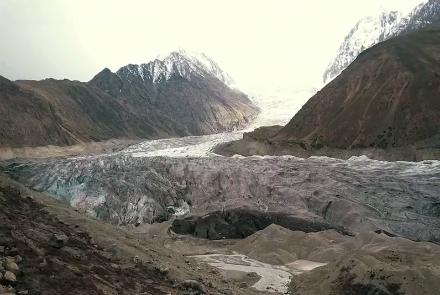There are nearly 4,000 glaciers lying up high in various regions of Afghanistan, but the climate change is severely threatening these highly important sources of water, according to international organizations and experts.
According to Geographic Information System and remote sensing research carried out by the International Center for Integrated Mounted Development (ICIMOD), Afghanistan has 3,620 ‘clean ice glaciers’, which are made up of snow layers that remain from one year to next in high altitude regions and are typically white or blue-white in color.
In total, Afghanistan’s 3,940 glaciers cover an overall area of 2,677 km2, an areas larger than the whole of Kapisa province.
The highest glacier is located at elevation of 7,213m and the lowest at 3,131m, both in the Wakhan corridor.
Experts said that climate change which takes roots from the spread of greenhouse gases in Afghanistan’s neighboring countries is the fundamental factor behind the melting of glaciers in Afghanistan’s mountain ranges.
“Almost 14 percent of the total area of glaciers was lost between 1990 and 2015, a direct result of climate change, and a reduction that can only be expected to continue,” according to a report published by the Afghan Analysts Network.
The melting of glaciers is also triggering catastrophic, rock-laden and floods.
“There are other factors too in Afghanistan like the destruction of the green belts, forest cutting that have direct impacts on the glaciers,” said Mohammad Qasim Haidari, the deputy head of the Natural Disasters Management Authority.
From the Hindu Kush in Afghanistan and the Tian Shan in Kazakhstan, Kyrgyzstan and China, stretching southeast to the eastern Himalayas of Nepal, Pakistan and India, is the area known as the High Mountain Asia Region, says the export.
The report says that it contains one of the highest concentrations of snow and glaciers outside the polar regions on the planet.
It is the source of South Asia’s freshwater; meltwater from the snow and glaciers feeds the ten largest river systems in Asia, which together support some 1.3 billion people in their downstream basin areas, in India, China, Nepal, Pakistan, Bangladesh and Afghanistan, says the report.
“The government should focus on this problem. There is a need for a swift action to be taken to avoid a massive challenge in future in the shape of a climate and human tragedy,” said Sayed Hussain Paktiawal, a member of parliament.
“There are dangers when the glaciers are melting down, it create water shortage, if the glaciers are protected, then surface and underground waters are also protected,” said Niazmuddin Khpolwak, a spokesman for the National Water Affairs Regulation Authority.
Last year, the World Bank in a report said that Afghanistan’s mountainous regions are faced with imminent threats of floods emerging from the melting of glaciers.
Recent flash floods in Panjshir and Parwan provinces can be taken as key examples to the danger, according to experts.


